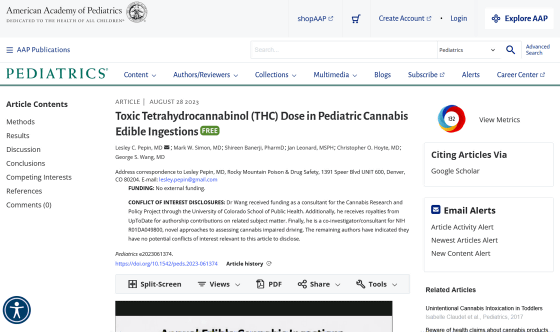There is a risk that infants may suffer from acute poisoning symptoms such as hypotension and respiratory failure just by eating two ``cannabis-containing gummies''

In recent years, various countries and regions around the world have been moving to legalize cannabis, and snacks and drinks containing
Toxic Tetrahydrocannabinol (THC) Dose in Pediatric Cannabis Edible Ingestions | Pediatrics | American Academy of Pediatrics
https://doi.org/10.1542/peds.2023-061374

It Only Takes a Bite of a Marijuana Edible to Send a Child to the Hospital
https://www.usnews.com/news/health-news/articles/2023-08-28/it-only-takes-a-bite-of-a-marijuana-edible-to-send-a-child- to-the-hospital
Eating just 2 cannabis gummies can put small kids at risk of toxic effects | Live Science
https://www.livescience.com/health/medicine-drugs/eating-just-2-cannabis-gummies-can-put-small-kids-at-risk-of-toxic-effects
Colorado, USA, was the first state in the United States to legalize recreational cannabis in 2014, and it has already been reported that the number of emergency visits related to cannabis use is rapidly increasing. Not only adults who voluntarily take cannabis, but also children who inadvertently eat gummies and cookies containing cannabis ingredients suffer from acute poisoning and are hospitalized. thing.
``Infant hospitalized for acute cannabis poisoning'' has increased sharply in areas where cannabis is legalized-GIGAZINE

So, a research team of doctors in Colorado analyzed cases of 'children under the age of 6 who were hospitalized after eating cannabis-infused food' and determined the THC intake threshold that causes acute poisoning symptoms in young children. I checked. Lead author of the study, Leslie Pepin, an emergency medicine specialist at Denver Health Medical Center, said: 'With the widespread legalization of cannabis, the number of unintentional exposures of children to cannabis is on the rise. For young children, these exposures are primarily due to edible cannabis products.'
Using medical records from the Colorado Children's Hospital Network, the researchers identified cases of hospitalization in children under the age of 6 after eating cannabis-infused foods between October 1, 2015, and October 25, 2022. did. Of the 151 cases of hospitalization after eating cannabis-containing foods, 80 cases in which the amount of THC ingested can be accurately determined were analyzed for factors such as intake and symptoms, child's weight and age.
The median age of the children surveyed was 2.9 years, and the amount of THC ingested ranged from 0.2 mg to 69.1 mg/kg body weight, with a median THC intake of 2.1 mg/kg body weight. In nearly 90% of cases, children found cannabis-containing food at home and ate it. was given to the child.
The study classified symptoms as 'severe,' including cardiovascular problems such as heart rate variability and low blood pressure, respiratory failure, seizures, and decreased responsiveness to stimuli, and took more than six hours to stabilize. was judged to be “long-term”. As a result of the analysis, it was found that `` 1.7 mg THC intake per kg body weight '' is the threshold indicating `` severe and long-term '' acute poisoning symptoms, regardless of the child's age or gender.
Cannabis-infused foods are designed for adults weighing tens of kilograms, and a typical 'cannabis-infused gummy' contains 10mg of THC per gummy. Therefore, an infant weighing about 11 kg can get severe acute poisoning after eating just two cannabis-containing gummies.

Children's symptoms appeared as early as 15 minutes after eating the cannabis-containing food, and most appeared 1-2 hours after eating. 'Early symptoms that parents may notice as signs that their child has ingested edible cannabis include drowsiness, nausea, vomiting, difficulty walking, confusion and
Sedation and lethargy were the most common symptoms seen in children, and 34 cases resolved without the need for treatment, while 37 cases had at least one or more severe symptoms. symptoms appeared and lasted for a median of 20.3 hours. In a few cases, children fell unconscious or needed a ventilator, but no children died.
The best way to protect children from cannabis-containing foods is to ``keep cannabis-containing foods in a locked area out of children's reach,'' Pepin said. There is also an opinion that producers can reduce the harm to children by reducing the THC content per piece and avoiding the shape of sweets that are attractive to children. said.

Related Posts:






